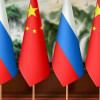China surging ahead at bullet speed

Cruising at a speed of 307 km/h, the bullet train ride from Shanghai to Beijing was smooth as silk—there was no klik klik sound typical of conventional trains as the wheels hit the short gaps between rails that we are all too familiar with on our all-too-typical trains. The only slight movement one feels on the Chinese version of the bullet train is when the turbulent wake of a passing bullet train makes the train squeeze against the air envelope of the opposing train.
As you see the neatly cultivated green farms fall away on both sides—and every once in a while, you stare at a town- or city-scape—you cannot but wonder at the homogeneity and sophistication of Chinese development.
From the bustling Shanghai train station teeming with thousands of people even on a Monday afternoon, waiting quietly in queues to board their trains, to the scores of well-designed cookie-cutter stations along the way efficiently whisking away countless travellers round the clock, to the thousands of acres of well-tended farmlands without any humans in sight, attesting to widespread mechanisation in agriculture, to huge factories and large construction sites punctuating the monotony of the greenery from time to time—they all point to a well-planned and thoughtfully executed socioeconomic development agenda across a huge country. I have travelled to China infrequently over the years—about five times over 20 years. From one trip to the next, it is easy to gauge the tempo and direction of development.
With four hours on my hand and a sleep-deprived brain, it was easy to get philosophical about the whirring scenes flashing past me raising all kinds of questions in my mind: What motivates the leaders to commit to such sustained socioeconomic development? What is the role of the system of governance and ideology behind such nation-building? Where could it all go in future?
China apparently "is a socialist state under the people's democratic dictatorship led by the working class," according to its constitution. People's democratic representation is by direct franchise at the lowest level but exercised by elected representatives at all upper layers all the way to the National Congress. The president elected by the Congress enjoys almost absolute power over the state machinery while the premier heads the government. Only the politburo of the Chinese Communist Party wields more power as a body than either of these offices. It seems that an overwhelming majority of Chinese populace (more than 85 percent by some estimates) support this type of pyramidal democracy with an absolute ruler at the top, which has allowed the nation to emerge as a middle-income country, leaving behind the shackles of poverty and destitution in only a few decades.
Throughout history, China has occasionally risen to the top of technology and knowledge only to suffer mind-numbing atrocities at the hands of absolute monarchs and nomadic hordes. The Chinese people have put up with all such cruel treatment through the ages with astounding equanimity and a philosophical bent of mind. Tens of millions of people have perished under several despotic rulers in the last thousand years, but every time China has bounced back.
As we roll past Qufu, the birthplace of Confucius, one cannot but wonder at the humanistic values of present-day Chinese society and the impact of Confucian teachings over the past two and a half millennia.
"What you do not wish for yourself, do not do to others" is the Confucian mantra of reciprocity that seems to have guided the macro-level foreign policy engagement of the Chinese over the centuries. A thousand years ago, China had the first standing navy in the world and the exploits of Admiral Zheng He in the 13th century is legendary. What is, however, interesting to note is that despite its clear military and technological superiority at the time, China was content to exchange pleasantries with the countries they discovered in their sea-faring ways and not put those distant lands under brutal subjugation or slavery, as was done a few centuries later when it was the turn of the Europeans to flex their navigational chops.
To secure its newfound economic and technological might, China is trying to retrace its roots in the trade routes known as the Silk Road in the Middle Ages. This new Silk Road is China's "One Belt, One Road" initiative. The Belt and Road Initiative, estimated to cost several trillions of dollars, is one of the largest infrastructure and investment projects in history, covering more than 68 countries, including 65 percent of the world's population and 40 percent of the global GDP as of 2017.
As we sample the Silk and the Pearl markets in Beijing, popular with the tourists for the wide variety of products that are on offer and the sellers' limited ability to communicate in English, one gets to see the seamy side of laissez-faire Chinese entrepreneurship: the price tags don't mean anything—you haggle in a free fall of prices and temper until you capitulate in exasperation or leave hurriedly to avoid capitulation—in neither case, you really know if you are getting a good bargain or walking away from one. Posit this with the shiny new airports strutting brand-new Airbuses and Boeings flown by Chinese airlines, one can see the economy is flying high but the high-handed authoritarian administration becomes apparent when planes get delayed for hours due to bad weather (not uncommon in commercial aviation) while the airlines offer scant or no information on when you may actually get to fly, or when you discover to your sheer disbelief that the connecting flight left without you and a dozen others simply because the doors to boarding the flight were closed at a regulated time even though the plane was sitting on the tarmac and several dozen passengers were still waiting to board. But in a clear sign of authoritarian control, with no delegation of functional authority to field managers, the airlines clearly lost business that it could easily cater to with a little adjustment of operational parameters—something that is quite common in the free world, whether in Dubai or Singapore or London, but not quite in China yet.
Despite these pitfalls, China is the largest economy in the world with the largest population of any nation marching ahead in sync with a central authoritarian regime, with a clear intent to go ahead in life and the world.
If the journey is the destination, then the bullet train epitomises the Chinese economic juggernaut in the last three decades as it embraced what they call "socialist market economy", a combination of state control and entrepreneurial freedom peculiar to China. Combined with the Confucian principle of reciprocity, the Chinese model is certainly worth closer scrutiny and deeper engagement as our biggest trading partner.
Habibullah N Karim is an author, policy activist, investor and serial entrepreneur. He is a founder and former president of BASIS and founder/CEO of Technohaven Company Ltd.
Email: [email protected]










Comments